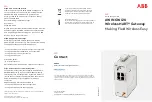
through the system. The issued IP addresses by the access point and
eth1
interface are in the
192.168.1.x
subnet. The default
access point SSID for the access point is
IDPDK-5591
. The bridge configuration can be modified using LuCi web interface. Follow
Intel/Wind River’s documentation for more details on configuring, WAN, WLAN, and br-LAN network interfaces using LuCi web
interface.
Bluetooth configuration
The system supports an integrated Bluetooth network interface. The Bluetooth network can be configured using LuCI web interface
on the Wind River Linux OS. To configure Bluetooth interface on the system with Wind River Linux OS.
1.
Log in to the LuCI web interface as identified in the steps referenced in the previous sections.
2.
Bluetooth configuration is supported under
Network
tab drop-down menu
Bluetooth
of the Web Interface.
•
Enable
Bluetooth
interface in this page and hit
Scan
to identify nearby other Bluetooth enabled devices.
Wireless WAN network interface configuration
Add-on modules can be installed on the edge gateway system to get Wireless WAN (WWAN) connectivity.
•
4G-LTE — Interface using Telit LE910 module for carrier AT&T
•
4G-LTE — Interface using Telit LE910 module for carrier Verizon
•
HSPA+ — Interface using Telit HE910 module
LE910 WWAN connection configuration
Follow the
Service Manual
to install the LE910 module and the corresponding carrier SIM card in the system. After the module and
SIM card is installed, activate the WWAN connectivity by:
NOTE: The default Wind River Linux OS image currently uses AT commands to configure WWAN interface and LTE
connectivity.
NOTE: LuCi web interface currently does not support configuring the WWAN interface.
Identifying installed WWAN module and Carrier
To identify the serial interface on the installed LE910 module’s tty ACM interface, using dmesg command:
# dmesg | grep –i
ttyacm
The system may contain more than one USB ACM device other than
Telit LE910
or
Telit HE910
module. Based on the output for the
dmesg command
, identify the
ttyacm ports
that were enumerated, for example, below is the output for
dmesg | grep –i
ttypacm
command for more than one USB ACM device on the system.
45
















































